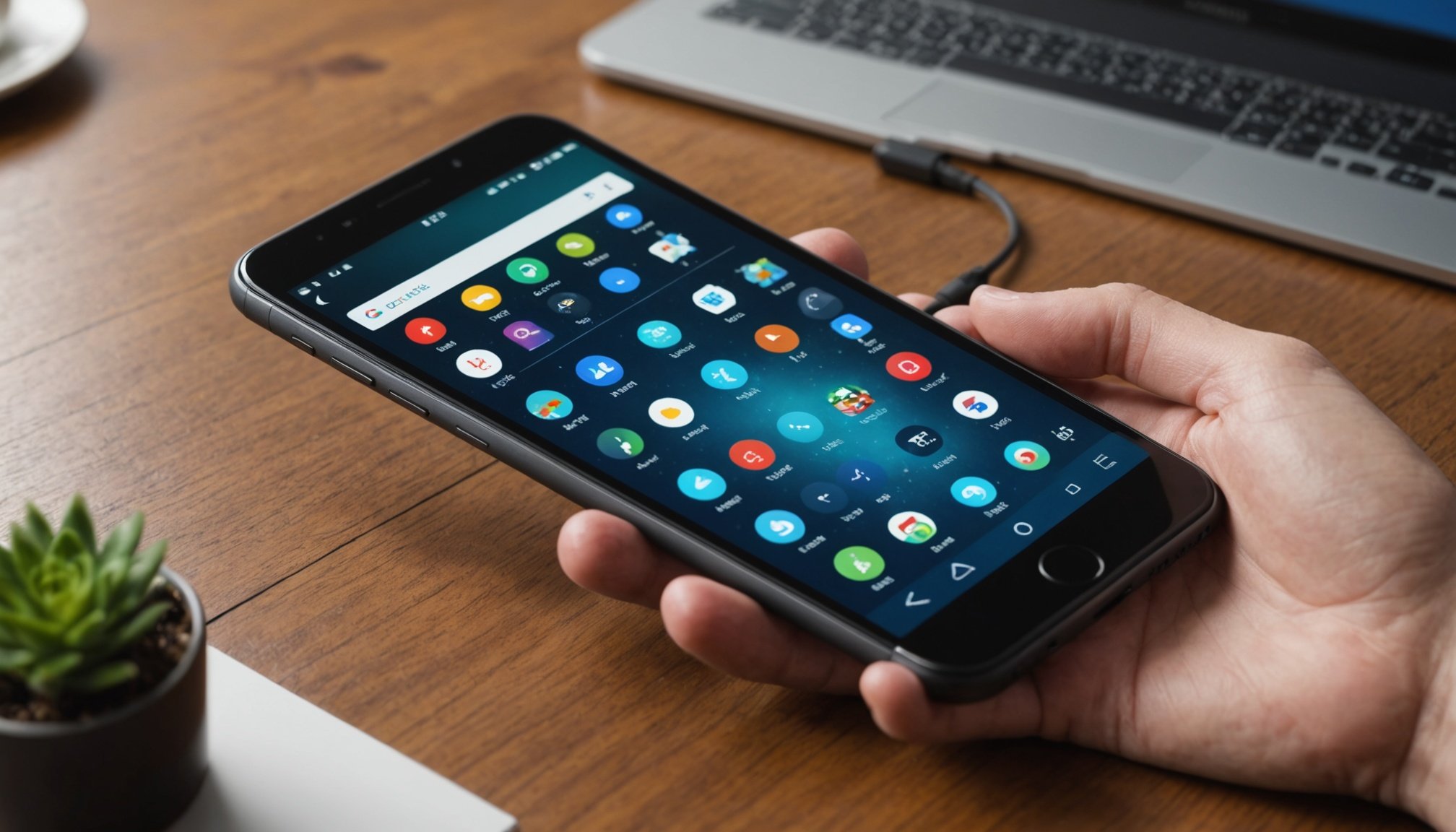Understanding Digital Ecosystems
A digital ecosystem consists of a network of interconnected digital tools and devices that work together to enhance effectiveness and productivity. This ecosystem includes components such as software applications, digital platforms, and online services that integrate seamlessly with one another. A vital aspect of managing this ecosystem is utilising smartphones, which act as central hubs for accessing various digital tools on-the-go. By effectively managing these tools using your smartphone, you can harness the full potential of the ecosystem.
One of the primary advantages of leveraging smartphones for managing digital tools is their portability, which allows for the continual management of tasks and communication. Smartphones enable easy access to productivity tools which can be pivotal in maintaining efficient workflows. These tools often include cloud storage services, task management applications, and communication platforms.
Also to see : Revolutionizing Mental Health Monitoring: The Power of AI-Driven Mobile Applications
Seamless integration within a digital ecosystem can significantly enhance productivity. It allows for effortless data sharing between apps and systems, reducing the time spent on manual data transfers. Implementing cross-platform compatibility is critical in achieving this integration, ensuring that all devices in the ecosystem work harmoniously.
In summary, understanding and effectively managing digital ecosystems using smartphones can result in more streamlined operations and improved productivity in both personal and professional settings.
Have you seen this : Elevate Your Gaming Experience: Essential Smartphone Configurations for Peak Performance
Understanding Digital Ecosystems
A digital ecosystem refers to a connected network of online tools, services, and devices that work together to enhance user productivity and manage digital tasks efficiently. At the heart of this ecosystem lies the smartphone, acting as a pivotal tool in handling digital interactions and synchronizing various applications.
Definition and Components
The digital ecosystem includes various components such as cloud services, interconnected applications, and responsive mobile technology. These components collaborate seamlessly to provide a cohesive user experience. Smartphones, being versatile devices, enhance the capability to manage this ecosystem by integrating numerous apps and services, thus acting as both a hub and a facilitator.
Importance of Smartphones
Utilizing smartphones for managing digital tools is vital in enhancing productivity. The capability of handling multiple applications, setting reminders, and organizing tasks in one place makes smartphones indispensable. With the right productivity tools, smartphones ensure efficiency by providing real-time data and enabling instant decision-making.
Seamless Integration for Enhanced Productivity
An effective digital ecosystem relies heavily on seamless integration, wherein digital tools connect and communicate without disruptions. This integration is crucial for managing workloads and optimizing the productivity of both individuals and businesses. By aligning productivity tools within the smartphone, users benefit from an organized and efficient workflow, reducing manual effort and mitigating the risk of errors.
Key Features of Effective Ecosystem Management
Digital ecosystems thrive when managed efficiently, with smartphones at the heart of productivity enhancement. One pivotal feature is centralized access, allowing users to access a unified platform for applications. This feature simplifies the user experience by aggregating various productivity tools into one interface. Apps like Evernote and Microsoft OneNote facilitate this by offering robust note-taking and organizational capabilities, which boost productivity by keeping information easily accessible.
Another critical aspect is cross-platform compatibility, ensuring seamless operation across different devices. This interoperability is vital in maintaining workflow efficiency. Apps such as Google Drive and Trello excel by syncing data across platforms, allowing users to transition effortlessly between devices. Compatibility enhances productivity by minimizing disruptions and ensuring consistent data access.
Lastly, automation and integration play crucial roles in simplifying workflows. Automation tools like IFTTT and Zapier streamline repetitive tasks and conserve valuable time. Successful integration strategies often involve connecting systems to automate data transfers and notifications. Case studies show that businesses employing these tools experience significant time savings and improved task management. By embracing these features, users can enhance their ecosystem management, leading to more effective use of digital tools and heightened productivity.
Key Features of Effective Ecosystem Management
Managing a digital ecosystem effectively requires leveraging the robust capabilities of smartphones. These devices are not just communication tools; they are powerful aids in ecosystem management thanks to their sophisticated features. Understanding the key features, and their impact on productivity is essential.
Centralised Access
Centralised access is a pivotal feature in ecosystem management. Having a unified platform for accessing various applications simplifies workflow. Apps like Microsoft Teams, Slack, and Trello enable users to consolidate communication, collaboration, and task management in one place. This centralisation significantly improves productivity by reducing the time spent switching between different tools and platforms.
Cross-Platform Compatibility
Ensuring cross-platform compatibility is crucial for seamless ecosystem management. It allows users to access their digital tools from any device, enhancing flexibility and efficiency. Apps such as Google Workspace and Evernote are designed to sync effortlessly across smartphones, tablets, and desktops. This compatibility ensures a smooth workflow, enabling users to work without interruptions regardless of the device they are using.
Automation and Integration
Automation is a game-changer in simplifying workflows and saving time. Smartphones offer a range of automation tools like IFTTT and Zapier, which help integrate diverse applications. Real-life case studies have shown that businesses using automation experience improved efficiency and reduced manual effort, highlighting the importance of successful integration strategies for productive ecosystem management.
Top Apps for Smartphone Ecosystem Management
In the landscape of smartphone management, having the right productivity apps can make a world of difference. Best apps in this domain are those that blend seamlessly into digital ecosystems, enhancing user efficiency.
Task Management Apps
When selecting task management apps, consider features such as ease of use, collaboration capabilities, and integration with other tools. Apps like Todoist and Asana are known for their intuitive interfaces and effective task-tracking features. Users often highlight the ability to break tasks into subtasks, which aids in managing workload more effectively.
Note-Taking and Organization Apps
Organization plays a pivotal role in managing digital content efficiently. Apps like Evernote and OneNote are excellent digital management tools for note-taking and document organization. These apps herald features like search capabilities and cross-device syncing. Users find value in capturing thoughts on the go and organizing them with ease through these apps.
Communication Tools
In any digital ecosystem, communication tools are essential for ensuring smooth interaction. Slack and Microsoft Teams are among the best apps for collaboration, supporting both text and video communication. By utilizing strategies such as setting designated times for interactions, users can maximize communication efficiency, making these tools indispensable in both personal and professional settings.
Top Apps for Smartphone Ecosystem Management
In today’s dynamic digital ecosystem, smartphones play a vital role in managing productivity tools effectively. Choosing the right apps is crucial to enhance smartphone management, ensuring seamless digital management.
Task Management Apps
Task management apps are at the core of successful smartphone management, enabling users to prioritize tasks and organize their schedules. Look for features such as intuitive interfaces, reminder settings, and real-time collaboration options. Popular apps like Asana and Todoist excel in these areas, offering robust solutions for digital management. User testimonials suggest heightened task efficiency and precision, describing these apps as essential tools in the digital ecosystem.
Note-Taking and Organization Apps
Organization is a key element in managing digital content effectively. Note-taking apps like Notion and OneNote provide versatile features, from digital notebooks to collaborative options. These apps assist in categorizing information and maintaining organized records. Tips for effective usage include leveraging search functionality to quickly retrieve notes and setting up folders to structure information logically.
Communication Tools
Communication tools are integral to the functioning of a digital ecosystem. Apps like Slack and Microsoft Teams facilitate team collaboration, helping maintain smooth communication. Implementing strategies like setting dedicated channels for projects and leveraging integration with other apps can maximize communication efficiency, enhancing overall smartphone management.
Tips for Maximizing Productivity
In today’s fast-paced world, improving productivity with smartphones goes beyond mere connectivity. To begin with, setting up notifications and due dates is crucial. These features act as gentle reminders and help maintain accountability, ensuring tasks are completed on time. It’s a simple yet effective strategy that harnesses the full potential of your digital ecosystem.
Another essential strategy involves establishing a regular review process for your digital tasks. This involves routinely checking and organising tasks, ensuring nothing slips through the cracks. Reviewing your progress regularly keeps you aligned with your goals and helps in identifying any bottlenecks.
To enhance focus, it’s equally important to minimize distractions. Smartphones, with their multitude of notifications and apps, can be both a boon and a bane. Strategically disabling non-essential notifications during work hours can drastically improve concentration and task efficiency.
Additionally, leveraging smartphone-specific productivity tools tailored to your everyday needs optimises performance. Whether it’s using a dedicated app for time tracking or employing features that block distracting content, the right tools can significantly amplify productivity.
Implement these smartphone strategies for an efficient work routine. With focus, diligence, and the right tools, your time management endeavours can transform into highly productive outcomes.
Tips for Maximizing Productivity
Navigating the vast array of productivity tools can be overwhelming, but there are specific strategies that enhance time management and boost output. Setting up notifications and due dates on your smartphone ensures tasks are not forgotten, acting as a constant reminder to maintain momentum in your work. Implementing these features keeps you accountable and facilitates an organised daily routine.
Moreover, establishing a regular review process for digital tasks can significantly contribute to productivity. This involves periodically assessing your workload, prioritising tasks, and adjusting timelines accordingly. Such strategic planning ensures optimal use of digital management tools, allowing for more efficient achievement of goals.
Minimizing distractions is also crucial to maintaining focus and concentration. Using smartphone settings to limit interruptions—such as disabling non-essential alerts or using the “Do Not Disturb” feature—provides an environment conducive to productive work. By reducing external noise, you can allocate more energy to completing tasks effectively.
Adopting these smartphone strategies not only enhances productivity but also streamlines your management approach within the digital ecosystem. By executing these techniques, users can create a well-structured workflow, yielding measurable improvements in both personal and professional productivity aspects.
Real-Life Case Studies
Exploring real-life case studies provides invaluable insights into the successes and challenges encountered in ecosystem management. Users have shared their experiences of streamlining daily tasks through effective utilisation of smartphone apps. By adopting specific strategies, they have achieved noticeable improvements in their daily routines.
Personal Experience: Streamlining Daily Tasks
A frequent approach involves strategically employing productivity tools to manage and simplify tasks. Users have described utilising apps like Todoist to prioritise tasks, enabling a more organised workflow. The results often include increased efficiency and time savings. Learning from these personal experiences, users highlight the importance of starting small and gradually incorporating more features of these apps to enhance their management capabilities.
Professional Experience: Enhancing Team Collaboration
In professional settings, leveraging smartphones for enhanced team collaboration is a common theme. A particular case involved a company’s transition to a smartphone-centric management approach using tools like Microsoft Teams. The result was improved communication and workflow efficiencies, showcasing the power of mobile technology. Emphasising continuous learning and adaptation, the team’s journey demonstrated that thoughtful integration of digital tools significantly boosts productivity.
Community Feedback: Collective Insights
Community feedback highlights common challenges in digital ecosystem management. Shared solutions often involve leveraging automation to address interruptions and inefficiencies. Users express a preference for apps offering seamless integration with existing tools, underlining a trend towards more unified and cohesive digital ecosystems.
Future Trends in Digital Ecosystem Management
The landscape of digital ecosystems is continually evolving, driven by emerging technologies that shape how we manage and integrate digital spaces. As new tools and features emerge, they introduce innovative ways to enhance productivity and connectivity within ecosystems.
One of the pivotal developments is the rise of artificial intelligence (AI) and machine learning, which are set to play crucial roles in automating and personalising ecosystem management tasks. These technologies promise smarter smartphone features that can predict user needs, automate routine processes, and offer proactive insights, thereby streamlining management tasks.
Moreover, augmented reality (AR) is anticipated to further revolutionize ecosystem management by providing immersive and interactive interfaces for digital tools. This innovation could enhance productivity tools by allowing users to visualize and manipulate data in real-time, offering new avenues for efficiency and engagement.
In terms of app development, there is a trend towards cross-compatibility and seamless integration, reinforcing the importance of adaptability. Apps that can effortlessly sync across devices will likely dominate, catering to the need for uninterrupted workflows. As digital landscapes transform, staying adaptable to these trends ensures that users can leverage cutting-edge technologies for maximum productivity.











